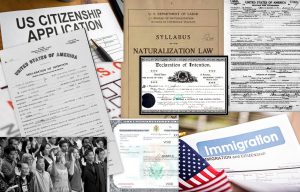
When researching our ancestors, one of the most important events, especially if they immigrated to America in the 19th and early 20th centuries, is their immigration and naturalization. The laws have changed multiple times and can be confusing if your ancestor is a woman or is non-white. The first Naturalization Act was passed in 1790. It only applied to white men.
Subsequent laws dealt with women and non-whites, and they were often changed and even repealed.
Below is a description of the changes in the laws from 1790 through 1952:
1790
Naturalization Act of 1790 – Two years residency; restricted to “free white persons” of “good moral character”
1795
Naturalization Act of 1795 – Five years residency plus three years’ notice of intent to apply for citizenship
1798
Naturalization Act of 1798 – 14 years residency and five years notice of intent to apply for citizenship
1802
Repealed and replaced the 1798 act; Five years residency and three years’ notice of intent to apply for citizenship. Resident children of naturalized citizens are considered citizens; children born broad of US citizens are considered citizens
1824
Reduced time from notice of intent to citizenship to 2 years. 5 years residency is still required.
1855
Women take on the citizenship of their husband through derivative citizenship.
1866
Civil Rights Act of 1866 provides that “All persons born in the US and not subject to any foreign power, excluding Indians not taxed are citizens, and such citizens of every race and color without regard to any previous condition of slavery or in servitude shall have the same rights as enjoyed by white citizens”.
1868
14th Amendment reads “All persons born or naturalized in the US, and subject to the jurisdiction thereof, are citizens of the US”
1870
Law expanded to allow African blacks to be naturalized; Asians could immigrate but could not be naturalized
1875
Page Act barred immigrants considered “undesirable,” defining this as a person from East Asia who was coming to the United States to be a forced laborer, any East Asian woman who would engage in prostitution, and all people considered to be convicts in their own country
1882
The Chinese Exclusion Act limited further Chinese immigration. The law was changed and repealed. Did not deal with naturalization issues.
1891
Expanded the list of exclusions for immigration from prior laws to include those who have a contagious disease and polygamists.
1903
Banned anarchists, beggars, and importers of prostitutes from immigrating.
1907
A Gentlemen’s Agreement stopped Japan from issuing visas, but many Japanese immigrants immigrated through Hawaii.
1907
Under the act of March 2, 1907, all women acquired their husband’s nationality upon a marriage that occurred after that date. However, U.S.-born citizen women could now lose their citizenship by any marriage to any alien.
1922
The Cable Act provided that a woman had a nationality of her own. No marriage since that date has granted U.S. citizenship to any alien woman nor taken it from any U.S.-born woman who married an alien eligible for naturalization. Under the new law, women became eligible to naturalize nearly on the same terms as men. A difference was for those women whose husbands had already naturalized. If her husband was a citizen, the wife did not need to file a declaration of intention. She could initiate naturalization proceedings with a petition alone.
1936
Women who were native-born citizens and lost citizenship because of marriage prior to September 22, 1922, are considered a citizen if they took the oath of allegiance and their marriage was terminated by either death or divorce.
1940
In 1940 Congress allowed all women who lost citizenship by marriage between 1907 and 1922 to repatriate, or resume their citizenship, regardless of their marital status. Since then, any woman who lost U.S. citizenship in those years by marriage to an alien could resume her citizenship by applying and taking the oath of allegiance.
1952
Declaration of Intent is no longer required; 5 years of residency is still required.
Additional Resources
- Read the National Archives article – “Naturalization Records” at https://www.archives.gov/research/immigration/naturalization
- Find Links to Free Online Naturalization collections in The Ancestor Hunt’s compilation of links by state at https://theancestorhunt.com/naturalization-records.html
- Visit Cyndi’s List for useful information links regarding Immigration, Emigration & Migration at https://www.cyndislist.com/immigration/